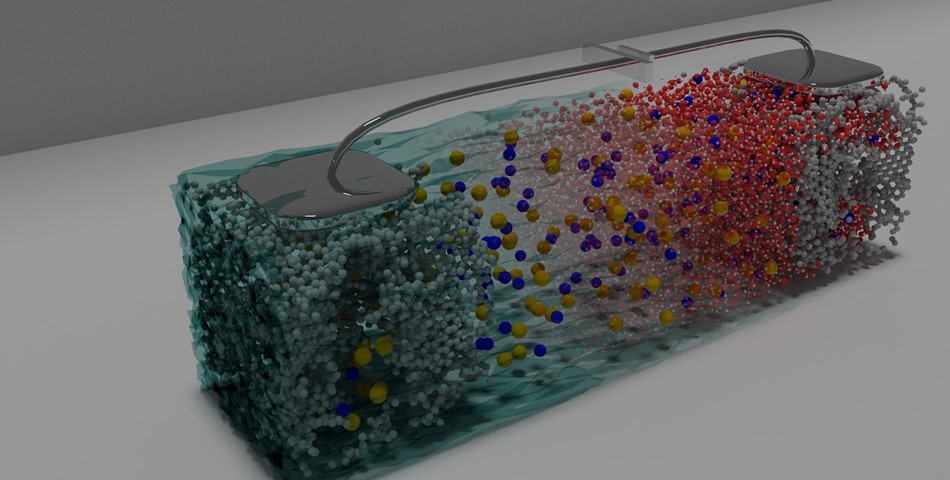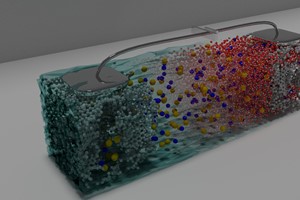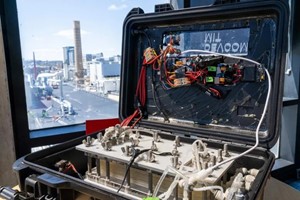Blue energy, which is the free energy lost when salty sea water and less salty river water meet and mix in estuaries, could become a significant source of global electricity in the future. Capacitive mixing, an up-and-coming technique that exploits the charge-discharge cycle of capacitors can be used to harvest this energy but optimizing the devices employed here has been no easy task. Researchers in France have now shown that molecular simulations can realistically predict the capacitance of devices that contain nanoporous carbon materials as the electrodes and salty water as the electrolyte. When run in reverse this technique is also an efficient way to desalinate water in a process known as capacitive deionization. In both capacitive mixing (CapMix) and capacitive deionization (CDI), electrodes made from nanoporous carbon have a bigger contact surface area with the electrolyte, thus upping the device’s specific capacitance. Researchers previously found that the capacitance of supercapacitors (also known as electric double layer capacitors, or EDLCs) unexpectedly increases when the pore size of carbide-derived carbon (CDC) electrodes used in these energy storage devices decreases down to the size of electrolyte ions. The problem is that these devices do not behave as models suggest when the size of the pores in the material reaches this size.
Molecular scale description
“Our starting point is a molecular scale description of water molecules, ions and of the nanoporous carbon electrodes, with a simplified representation of the interactions between them,” explains team leader Benjamin Rotenberg of the French National Center for Scientific Research (CNRS) and Sorbonne Université in Paris. “We take two important features into account: the complex structure of the electrode material and how it is polarized by the electrolyte when a voltage is applied between the electrodes. “We then proceed to ‘numerical experiments’ and look at the trajectory of every atom/molecule in the system. From the data obtained, we compute properties that can be directly compared to experimental results – for example, the capacitance of the devices. Good agreement between the two backs up our model.” In the context of blue energy, researchers rely on two theories of the interface between electrodes and electrolytes: the Debye-Huckël and Poisson-Boltzmann theories. These are very useful in many cases – for example, for planar or porous electrodes with very large pores. “However, they do fail in the present case of extreme confinement, in which molecular effects play an important role,” says Rotenberg.
Simpler description
As for CDI, another model, the modified Donnan model is frequently used. “This is an even simpler description of the equilibrium between the nanopores and the bulk electrolyte,” explains Rotenberg. “It introduces effective parameters that are usually adjusted to fit experimental data. “While using parameters from the literature for similar materials does not allow us to reproduce our experimental results under all conditions, we can obtain good predictions by fitting the parameters of a modified Donnan model to reproduce the simulations at high electrolyte salt concentrations. In this way, we can extrapolate the predictions to lower salt concentrations without doing any actual experiments.” Although not ideal, the researchers say the approach allows them to predict the experimental capacitance of their devices at lower salt concentrations fairly well.
Reliably predicting capacitance
“Our work confirms that nanoporous carbon electrodes, which are already employed in supercapacitors to store energy, show promise for both CapMix and CDI,” Rotenberg tells nanotechweb.org. “It also proves that realistic molecular dynamics simulations are good for investigating the fundamental mechanisms at play in these materials. And that the simulations can be used to reliably predict capacitance – especially at high salt concentrations.” The team, which includes scientists from the Université de Toulouse, within the framework of the French research network on electrochemical energy storage, RS2E, says that it is now busy simulating other salts to address ion specific effects. “We are also looking into different carbon structures and developing improved simple descriptions that will allow us to overcome the shortcomings of our molecular simulations. Their computational cost unfortunately does not yet allow us to simulate the behavior of electrolytes that have salinities comparable to that of river water.”
The Partnership for Advanced Computing in Europe
www.prace-ri.eu














